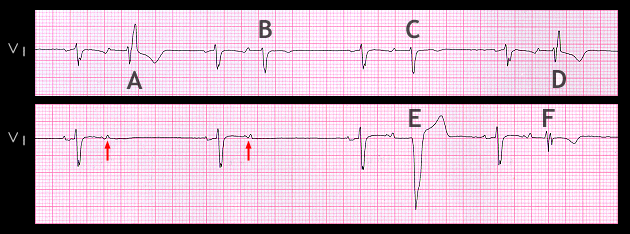
Atrial premature beats may be conducted with aberration resulting in multiple QRS wave forms. The two strips of lead V1 shown here were recorded from the same patient one week apart. Both strips show atrial premature beats in a pattern of bigemminy and a variety of QRS waveforms that represent different types of aberrancy. In the upper strip, all of the atrial premature beats are conducted to the ventricles. Beats A and D demonstrate different degrees of right bundle branch block aberrancy while beats B and C more closely resemble the sinus QRS complexes. In the lower strip, the first two atrial premature beats (arrows) do not conduct to the ventricles. The QRS complex labeled E shows left bundle branch block and beat F demonstrates incomplete right bundle branch block. This variability in conduction patterns through the AV node and His-Purkinje system indicates whether the AV node is absolutely refractory, in which case conduction will be blocked, or whether some regions of the more distil conducting system are either absolutely or relatively refractory, in which case the interventricular and/or intraventricular conduction will be slowed and abnormal, producing multiform QRS complexes such as those shown here.
